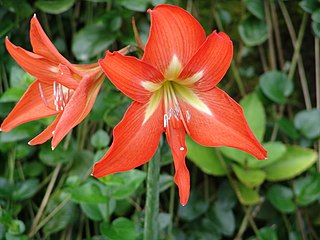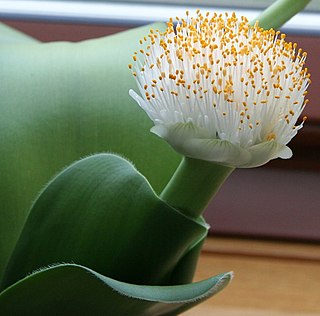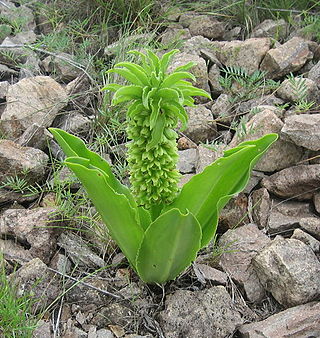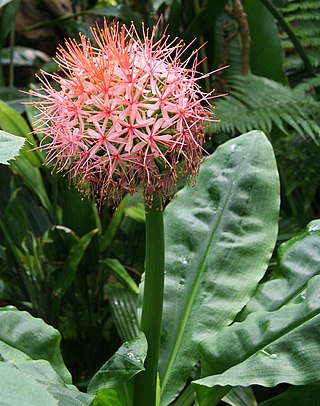
Hippeastrum is a genus of about 90 species, and over 600 hybrids and cultivars, of perennial, herbaceous and bulbous plants, native to tropical and subtropical regions of the Americas, from Mexico south to Argentina and on some islands in the Caribbean. The majority have large, fleshy bulbs—usually about the size of a softball—and tall, broad, strap-like leaves that are (generally) evergreen, and large red or purple flowers. Numerous colors and cultivars have been created over the past hundred years.

Haemanthus is a Southern African genus of flowering plants in the family Amaryllidaceae, subfamily Amaryllidoideae. Members of the genus are known as blood lily and paintbrush lily. There are some 22 known species, native to South Africa, Botswana, Namibia, Lesotho and Eswatini. About 15 species occur in the winter rainfall region of Namaqualand and the Western Cape, the remainder being found in the summer rainfall region, with one species Haemanthus albiflos occurring in both regions.

Eucrosia is a genus of herbaceous, perennial and bulbous plants in the Amaryllis family distributed from Ecuador to Peru. The name is derived from the Greek eu, beautiful, and krossos, a fringe, referring to the long stamens. As circumscribed in 2020, the genus contains six species. Phaedranassa and Rauhia are the genera most closely related to Eucrosia.

Strumaria is a genus of African plants in Amaryllis family, subfamily Amaryllidoideae. The genus is known in nature only from South Africa, Lesotho and Namibia. Almost all species flower in the autumn and are cultivated as ornamental bulbous plants.

Scadoxus puniceus, commonly known as the paintbrush lily, is a species of bulbous plant. It is native to much of southern and eastern Africa: Ethiopia, Sudan, Tanzania, Malawi, Mozambique, Zambia, Zimbabwe, Botswana, Eswatini (Swaziland), and South Africa. Scadoxus puniceus can be found in cool, shady habitat such as ravines and forests, where it is often found in moist leaf litter. Other common names include snake lily, royal paintbrush, King-of-Candida, African blood lily (English), rooikwas (Afrikaans), isisphompho, and umgola (Zulu). There are nine species of Scadoxus of which three, S. puniceus, S. multiflorus and S.membranaceus, occur in South Africa.

Scadoxus is a genus of African and Arabian plants in the Amaryllis family, subfamily Amaryllidoideae. The English names blood lily or blood flower are used for some of the species. The genus has close affinities with Haemanthus. Species of Scadoxus are grown as ornamental plants for their brilliantly coloured flowers, either in containers or in the ground in frost-free climates. Although some species have been used in traditional medicine, they contain poisonous alkaloids.

Scadoxus cyrtanthiflorus is a herbaceous plant endemic to the Rwenzori Mountains of east tropical Africa. Unusually for the genus Scadoxus its tubular blooms are pendant. It is sometimes grown as an ornamental plant in heated greenhouses.

Eucomis autumnalis, the autumn pineapple flower, or autumn pineapple lily, is a species of flowering plant in the family Asparagaceae, subfamily Scilloideae, native to Malawi, Zimbabwe and southern Africa. It is a mid to late summer flowering deciduous bulbous perennial. The flower stem reaches about 40 cm (16 in), rising from a basal rosette of wavy-edged leaves. The green, yellow or white flowers are arranged in a spike (raceme), topped by a "head" of green leaflike bracts. It is grown as an ornamental garden plant and can also be used as a cut flower.
Eucrosia mirabilis is a species of plant from Ecuador. In the original scientific description in 1869, it was believed to be from Peru, but there is little evidence it ever grew there. The plant disappeared from cultivation until it was found in Ecuador in 1997. Its natural habitats are seasonally dry lowland areas to elevations of 1500 m.
Blood lily is a common name for several plants and may refer to:

Scadoxus multiflorus is a bulbous plant native to most of sub-Saharan Africa from Senegal to Somalia to South Africa. It is also native to Arabian Peninsula and to the Seychelles. It is naturalized in Mexico and in the Chagos Archipelago.It is also found in Indian peninsula. It is grown as an ornamental plant for its brilliantly coloured flowers, either in containers or in the ground in where the climate is suitable. There are three recognized subspecies. Strongly toxic like other Scadoxus species, it has been used as a component of arrow poisons and fishing poisons, as well as in traditional medicine. Common names, some of which are used for other species, include blood lily, ball lily, fireball lily, blood flower, Katherine-wheel, oxtongue lily, poison root and powderpuff lily.

Hymenocallis caribaea is a plant in the Amaryllidaceae with the common names "Caribbean spider-lily" or "variegated spider-lily." It is native to the islands of the Caribbean and to northern South America. It is regarded as native to Puerto Rico, Jamaica, Hispaniola, Cuba, the Virgin Islands, and the Windward and Leeward Islands, and the Venezuelan Antilles. It is also commonly cultivated as an ornamental in many other tropical and subtropical regions and reportedly naturalized in Sri Lanka, New South Wales, Bermuda, French Guinea, Suriname, and Guyana.

Ammocharis nerinoides is a plant species endemic to Namibia, known from the Gobabis and Etoshapan Districts. It occurs in desert regions in river beds occasionally flooded with seasonal rainfall. It is also cultivated elsewhere for its showy flowers.

Scadoxus cinnabarinus is a herbaceous plant from tropical rainforest in Africa. It is native to Western and Central Africa from Sierra Leone in the far west to Angola in the south. It has been reported from Ghana, Côte d'Ivoire, Nigeria, Niger, Sierra Leone, Central African Republic, Cameroon, Congo, Equatorial Guinea, Gabon, São Tomé, Zaire, Uganda, and Angola.
Scadoxus longifolius is a herbaceous plant from Zaire. It is only known from a single collection, and little information is available about it. It appears to be closely related to Scadoxus cinnabarinus, and Inger Nordal and Thomas Duncan suggested in 1984 that it may not be a distinct species.
Scadoxus nutans is a herbaceous plant endemic to southwest Ethiopia. Its red to pink flowers face downwards as the top of the flowering stem bends over, unlike any of the other species of Scadoxus. It grows mainly as an epiphyte in tropical mountain forests, which are disappearing, making the species vulnerable to extinction. It is sometimes cultivated as an ornamental plant.

Scadoxus pole-evansii, commonly known as the Inyanga fireball, is a herbaceous plant endemic to mountains in east Zimbabwe. It was only discovered for science in 1960. Similar in many respects to the more widely grown Scadoxus multiflorus, it is cultivated as an ornamental plant.
Scadoxus pseudocaulus is a herbaceous plant native to Nigeria, Equatorial Guinea, Cameroon and Gabon. Similar in many respects to Scadoxus cinnabarinus, it is cultivated as an ornamental plant but has proved reluctant to flower.

Haemanthinae is a small subtribe of Haemantheae, and therefore within the African clades of Amaryllidoideae. It consists of two genera, Haemanthus, and Scadoxus.
Strumaria discifera is a species of flowering plant in the family Amaryllidaceae, native to west and south-west Cape Provinces. It was first described in 1992.














